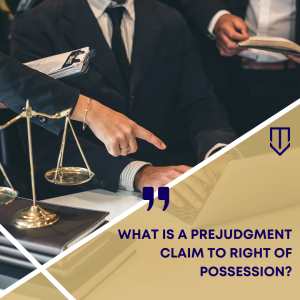 A Prejudgment Claim to Right of Possession is a form used for the purpose of avoiding third-party claims in an eviction/unlawful detainer action. The Prejudgment Claim to Right Possession is for the purpose of giving notice to any unnamed occupants of a subject property that an eviction action has been initiated. After a prejudgment claim to right of possession, any unnamed occupants may file their own prejudgment claim form to preserve their rights in the subject property. If said unnamed occupants fail to do so, those unnamed occupants will lose their rights in the subject property, and the eviction action may proceed.
A Prejudgment Claim to Right of Possession is a form used for the purpose of avoiding third-party claims in an eviction/unlawful detainer action. The Prejudgment Claim to Right Possession is for the purpose of giving notice to any unnamed occupants of a subject property that an eviction action has been initiated. After a prejudgment claim to right of possession, any unnamed occupants may file their own prejudgment claim form to preserve their rights in the subject property. If said unnamed occupants fail to do so, those unnamed occupants will lose their rights in the subject property, and the eviction action may proceed.
However, if the litigant filing the eviction action fails to file a prejudgment claim to right of possession, and an unnamed tenant does file a prejudgment claim, then the eviction will be delayed in order for a hearing to take place to determine if the unnamed tenant should have been included as a defendant in the original eviction action. At Underwood Law Firm, our attorneys are more than familiar with prejudgment claims to right of possession.
 California Partition Law Blog
California Partition Law Blog


 A Heggstad petition is a unique legal maneuver in probate court that a party can use to establish the existence of a trust. Normally, if a party wants to show that the property at issue is in a family trust, they have to produce evidence of a transfer of the property into the trust. (Prob. Code § 15200 (b).) This is usually accomplished with a deed, which conveys the property from the owners (the “settlors”) to the trustees of the trust.
A Heggstad petition is a unique legal maneuver in probate court that a party can use to establish the existence of a trust. Normally, if a party wants to show that the property at issue is in a family trust, they have to produce evidence of a transfer of the property into the trust. (Prob. Code § 15200 (b).) This is usually accomplished with a deed, which conveys the property from the owners (the “settlors”) to the trustees of the trust.  An action for accounting is an equitable action seeking to determine the amount owed to the parties of an action when damages are uncertain. “An accounting is an equitable proceeding which is proper where there is an unliquidated and unascertained amount owing that cannot be determined without an examination of the debits and credits on the books to determine what is due and owing.” (
An action for accounting is an equitable action seeking to determine the amount owed to the parties of an action when damages are uncertain. “An accounting is an equitable proceeding which is proper where there is an unliquidated and unascertained amount owing that cannot be determined without an examination of the debits and credits on the books to determine what is due and owing.” ( A
A  A deed of trust is a commonly used mortgage document in California. Essentially, a deed of trust provides a lender with security for the repayment of the loan and effectively functions
A deed of trust is a commonly used mortgage document in California. Essentially, a deed of trust provides a lender with security for the repayment of the loan and effectively functions  A “TIC” Agreement is a contractual agreement between tenants in common to real property. Because each tenant in common is a co-owner of the property, these agreements can help spell out the rights of each, preventing future disputes over payment or occupation. And, if the dispute cannot be prevented, the agreement, acting as a binding contract, provides a clear guideline for a judge to use in a court action, ensuring that the lawsuit moves along as quickly as possible.
A “TIC” Agreement is a contractual agreement between tenants in common to real property. Because each tenant in common is a co-owner of the property, these agreements can help spell out the rights of each, preventing future disputes over payment or occupation. And, if the dispute cannot be prevented, the agreement, acting as a binding contract, provides a clear guideline for a judge to use in a court action, ensuring that the lawsuit moves along as quickly as possible.  In California, a person can claim title to a piece of real property that they are not a titleholder to through adverse possession. Adverse possession requires a person to be in use of a particular piece of real property for the required statutory period. An adverse possessor, however, does not become the titleholder of a piece of property merely by using the property. Certain elements are required for a claimant to acquire title through adverse possession. The requirements for adverse possession are codified in the California Code of Civil Procedure section 323.
In California, a person can claim title to a piece of real property that they are not a titleholder to through adverse possession. Adverse possession requires a person to be in use of a particular piece of real property for the required statutory period. An adverse possessor, however, does not become the titleholder of a piece of property merely by using the property. Certain elements are required for a claimant to acquire title through adverse possession. The requirements for adverse possession are codified in the California Code of Civil Procedure section 323. A motion to determine title is a motion to the court requesting that the court establish title to a piece of real property. Typically, a motion to determine title shows up in the court as a quiet title action. A quiet title action is brought when a litigant seeks to establish that they have an ownership interest in the subject property and refute any adverse claims against the litigant. It follows that to prevail on a motion to determine title; one must show that they hold some ownership interest in the subject property.
A motion to determine title is a motion to the court requesting that the court establish title to a piece of real property. Typically, a motion to determine title shows up in the court as a quiet title action. A quiet title action is brought when a litigant seeks to establish that they have an ownership interest in the subject property and refute any adverse claims against the litigant. It follows that to prevail on a motion to determine title; one must show that they hold some ownership interest in the subject property.  Yes, but only in specific circumstances. When thinking of lawsuits, most people associate them with individuals. John may sue Mary for battery, for example. But this isn’t always the case. A large part of the law is devoted to virtual representation because some people, like minors, simply cannot file suit.
Yes, but only in specific circumstances. When thinking of lawsuits, most people associate them with individuals. John may sue Mary for battery, for example. But this isn’t always the case. A large part of the law is devoted to virtual representation because some people, like minors, simply cannot file suit.  When there are two or more owners of a piece of real property who are unable to come to an agreement on how to divide the property, any co-owner of the subject property may petition the court to partition the property. This is known as a partition action. Generally, the decision of a court to partition the property is merely the first step in the partition process. Although a partition action may sound quite simple, it is a complex process that requires extensive accounting and patience.
When there are two or more owners of a piece of real property who are unable to come to an agreement on how to divide the property, any co-owner of the subject property may petition the court to partition the property. This is known as a partition action. Generally, the decision of a court to partition the property is merely the first step in the partition process. Although a partition action may sound quite simple, it is a complex process that requires extensive accounting and patience.